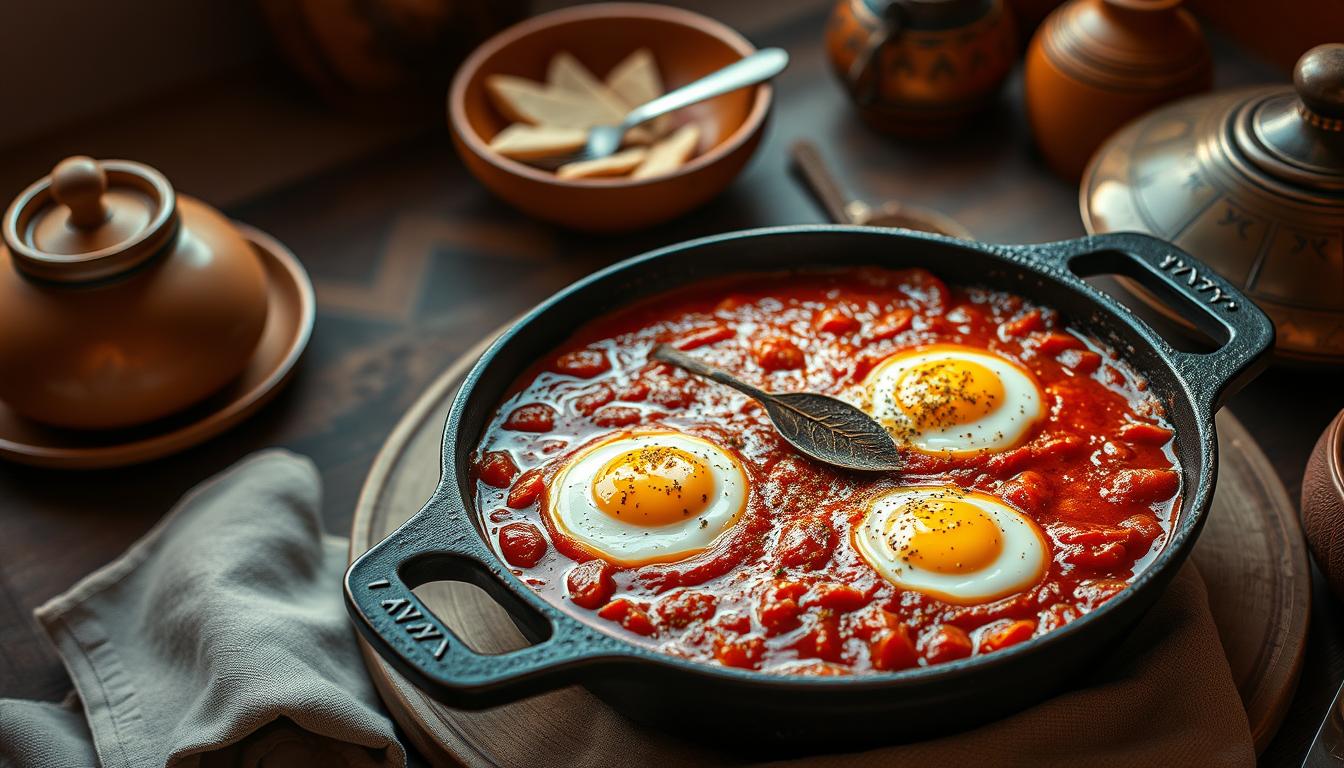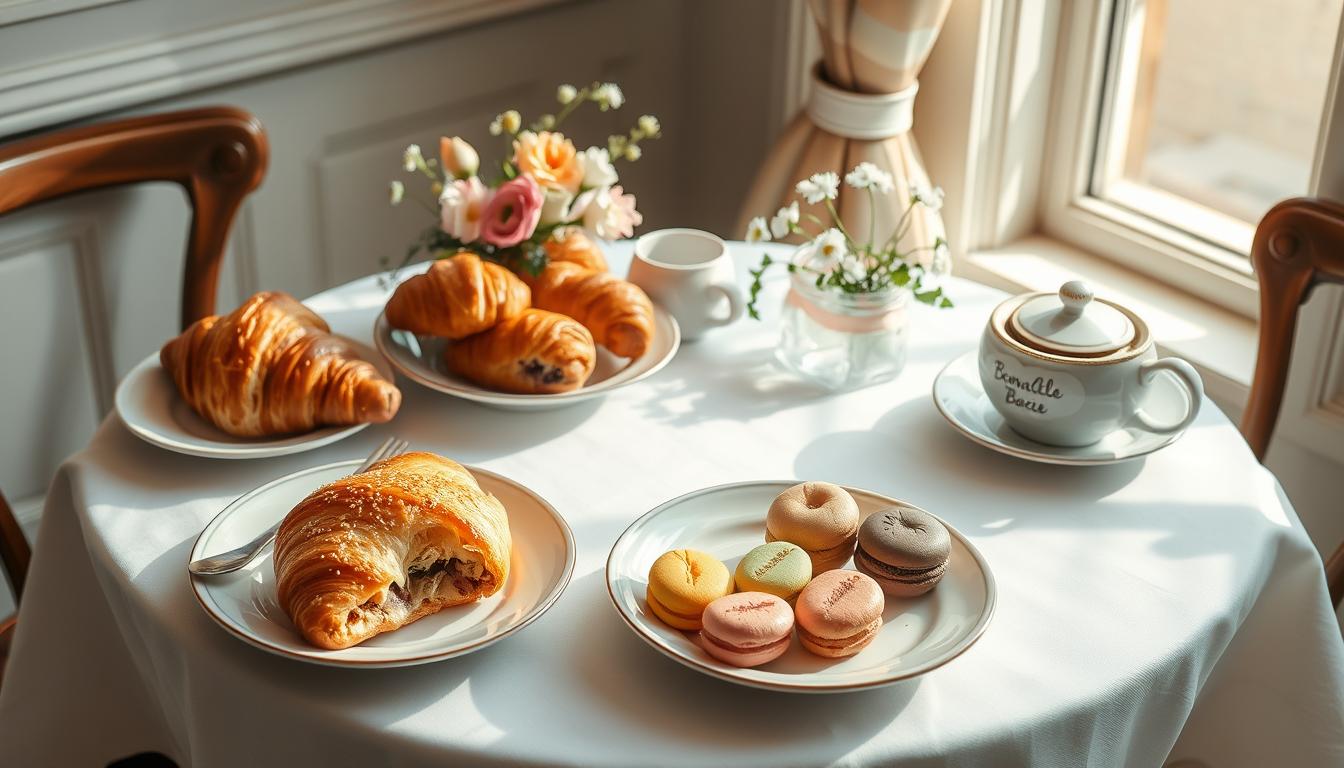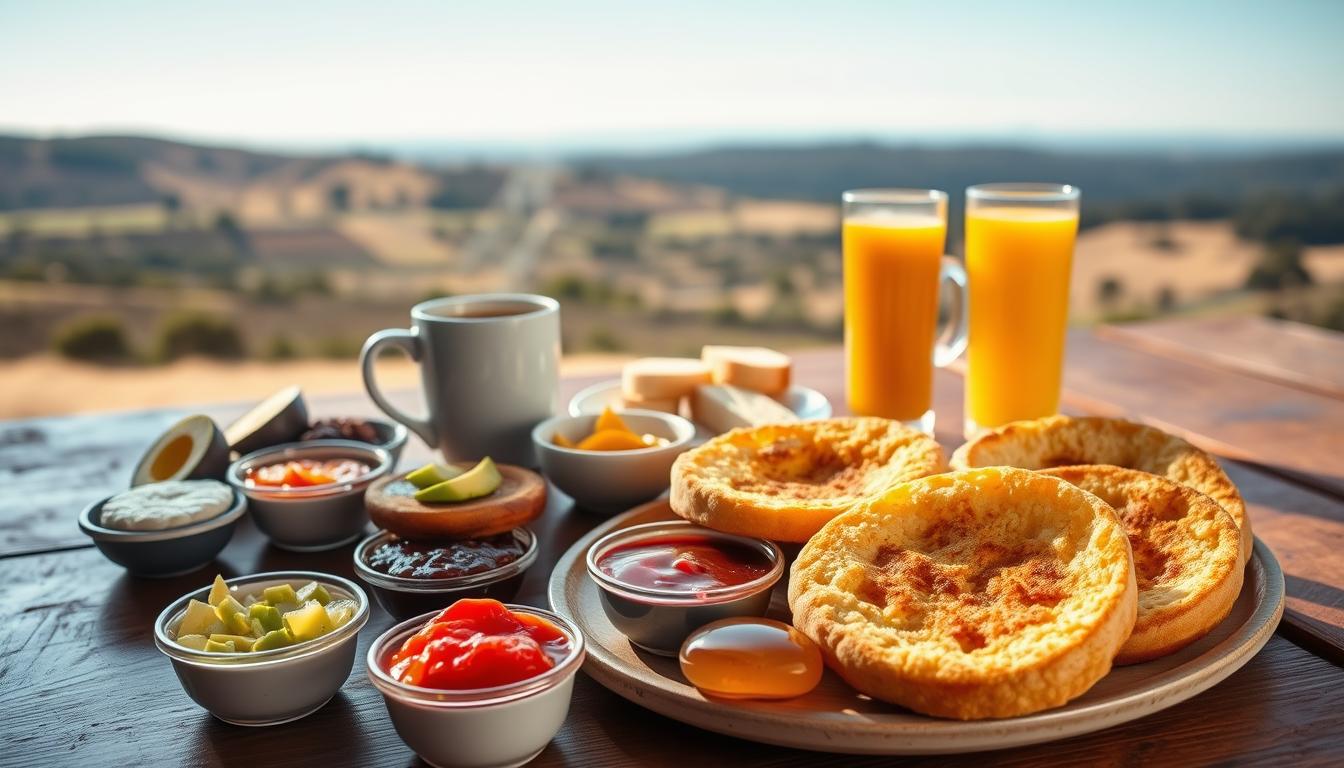Traditional Indian Breakfast Dishes to Make: Your Morning Delight

Imagine starting your morning with a flavorful and nutritious breakfast that not only delights your taste buds but also provides a boost to your day.
Indian cuisine offers a diverse and vibrant array of breakfast options that cater to various tastes and dietary preferences. From the spicy kick of South Indian idlis and dosas to the comforting warmth of North Indian parathas and poha, there’s something for everyone.
Exploring these authentic recipes can transform your morning routine into a culinary adventure, providing a perfect blend of nutrition, taste, and satisfaction.
Key Takeaways
- Discover diverse and vibrant Indian breakfast options.
- Learn to make authentic Indian breakfast recipes at home.
- Understand the nutritional benefits of Indian breakfast cuisine.
- Explore various regional breakfast specialties.
- Transform your morning routine with flavorful and nutritious breakfast dishes.
The Rich Tradition of Indian Breakfast
The rich tradition of Indian breakfast is a testament to the country’s culinary diversity. Indian breakfasts are not just meals; they are experiences that vary greatly across the country, reflecting local ingredients, cultural practices, and historical influences.
Cultural Significance of Breakfast in Indian Households
In Indian households, breakfast is often considered a crucial meal that sets the tone for the day. It’s a time for family bonding and is frequently prepared with love and care, using traditional recipes passed down through generations. The cultural significance of breakfast is evident in the way it’s prepared and consumed, often involving rituals and specific ingredients believed to provide energy and nourishment throughout the day.
Breakfast in India is a meal that is deeply rooted in tradition and culture. It’s not just about the food; it’s about the experience and the values it represents, such as family, nourishment, and the start of a new day.
Regional Diversity in Indian Breakfast Cuisine
India’s vast geographical expanse has given rise to incredibly diverse breakfast traditions. Each region showcases unique ingredients, cooking methods, and flavor profiles. For instance, Northern India favors hearty wheat-based breakfasts like parathas and chole bhature, reflecting the agricultural patterns and cooler climate of the region.
In contrast, Southern Indian breakfast cuisine centers around fermented rice and lentil preparations like idli, dosa, and uttapam, showcasing the region’s rice cultivation heritage. Western India, particularly Gujarat and Maharashtra, offers distinctive breakfast options like dhokla, thepla, and poha that balance flavor with nutritional needs. Eastern Indian breakfast traditions feature unique dishes like luchi with aloo dum and dal parathas, demonstrating the region’s distinctive culinary approach.
This regional diversity means you can experience a different Indian breakfast every day of the week, each telling its own cultural story through food.
Why Traditional Indian Breakfast Dishes Are Worth Making
Traditional Indian breakfast dishes are not just a meal; they’re an experience that combines various flavors, textures, and nutrients. Ensuring that your first meal has a balanced amount of macronutrients and is rich in vitamins and minerals is crucial for a healthy day. Indian breakfast dishes masterfully achieve this balance, making them an excellent choice for your morning meal.
Nutritional Benefits of Indian Breakfast Options
Indian breakfast recipes are designed to provide a balanced mix of carbohydrates, proteins, and fats, along with essential vitamins and minerals. Many Indian breakfast dishes incorporate fermentation processes, which not only create unique textures and flavors but also increase the bioavailability of nutrients. For instance, dishes like idli and dosa, which are made using fermented rice and lentil batter, are rich in nutrients and easier to digest.
The use of various grains, lentils, and vegetables in Indian breakfast dishes ensures a broad spectrum of nutrients. For example, upma, made with semolina, vegetables, and spices, is a nutrient-dense breakfast option that provides sustained energy.
Balance of Flavors and Textures
One of the standout features of Indian breakfast cuisine is its ability to balance multiple flavor profiles and textures in a single meal. Indian breakfast dishes often combine sweet, salty, sour, spicy, and umami flavors, creating complex taste experiences that engage your palate fully. The textural diversity is equally impressive, with a single meal often featuring crispy elements like dosa edges, soft components like idli centers, and creamy accompaniments like chutneys.
The thoughtful pairing of main dishes with complementary sides and chutneys demonstrates the sophisticated culinary understanding that has evolved over centuries in Indian cooking. Learning to create these balanced flavor and texture combinations at home will transform your understanding of what breakfast can be and elevate your overall cooking skills.
- The layering of spices at different cooking stages creates depth of flavor that makes even simple ingredients like rice or potatoes taste extraordinary in Indian breakfast preparations.
- The incorporation of various ingredients and cooking techniques ensures that Indian breakfast dishes are not only delicious but also nutritious.
Essential Ingredients for Traditional Indian Breakfast Dishes to Make
The foundation of a delicious Indian breakfast lies in the quality and variety of ingredients used. Indian cuisine is renowned for its rich flavors and diverse textures, which are achieved through the careful selection of spices, grains, and other components.
To start, let’s explore the common spices and herbs that form the backbone of many Indian breakfast dishes. These ingredients not only add flavor but also provide numerous health benefits.
Common Spices and Herbs
Indian cuisine is known for its liberal use of spices and herbs, which are often combined in complex blends to create unique flavor profiles. Some of the most commonly used spices include turmeric, cumin, coriander, and chili peppers. Fresh herbs like cilantro and mint are also frequently used to add freshness and depth to various dishes.
- Turmeric: Adds a warm, earthy flavor and has anti-inflammatory properties.
- Cumin: Provides a rich, earthy flavor and aids digestion.
- Coriander: Has a sweet, citrusy flavor and is rich in antioxidants.
- Chili Peppers: Add heat and are rich in vitamin C.
Flours and Grains
Various types of flours and grains are used in Indian breakfast dishes, each offering distinct textures and flavors. Some of the most commonly used include rice flour, chickpea flour, and whole wheat flour.
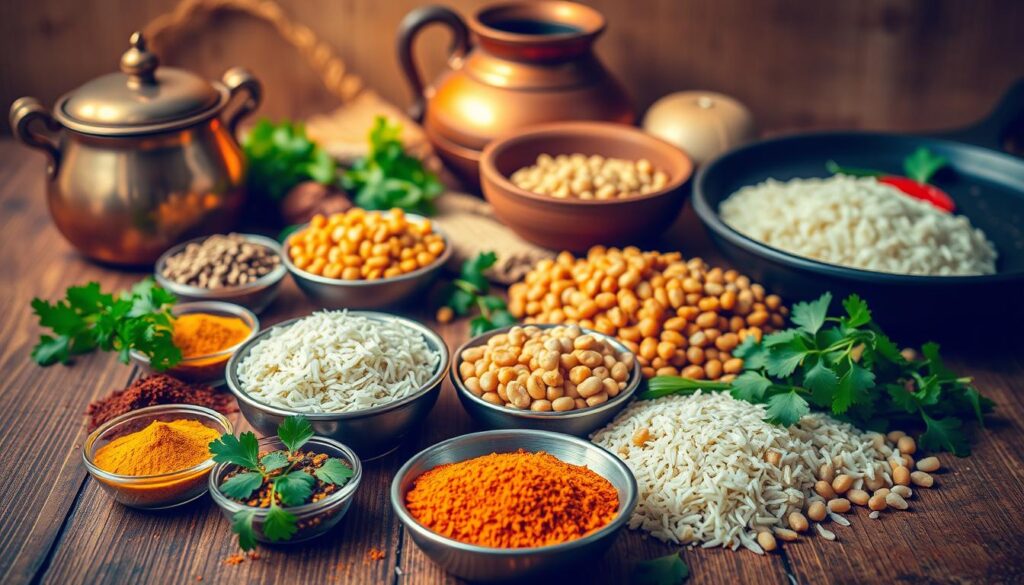
- Rice Flour: Used to make dishes like idli and dosa, it provides a soft, delicate texture.
- Chickpea Flour: Used in dishes like besan cheela, it is high in protein and adds a nutty flavor.
- Whole Wheat Flour: Used for making parathas and other flatbreads, it is rich in fiber and nutrients.
Accompaniments and Chutneys
Accompaniments and chutneys play a crucial role in enhancing the flavor and enjoyment of Indian breakfast dishes. Some popular options include coconut chutney, tamarind chutney, fresh yogurt, and pickles.
- Coconut chutney provides a cooling contrast to spicy dishes.
- Tamarind chutney adds a tangy, sweet-sour flavor.
- Fresh yogurt serves as a cooling side dish and adds protein and probiotic benefits.
- Pickles offer intense bursts of flavor and enhance simpler breakfast items.
South Indian Breakfast Delights
Exploring South Indian breakfast delights is like uncovering a treasure trove of flavors. The region’s morning meals are a perfect blend of tradition, nutrition, and taste.
South Indian breakfast cuisine is known for its diversity and richness. From steamed idlis to crispy dosas, and from savory upma to comforting pongal, there’s a dish to suit every palate.
Idli and Sambar
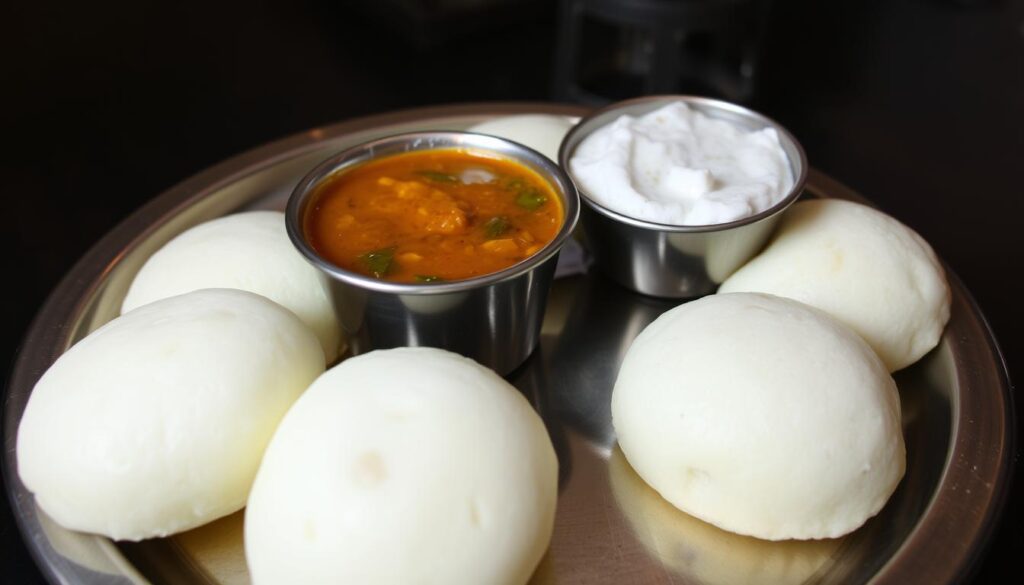
Idli and sambar is a classic South Indian breakfast combination that’s both nourishing and delicious. Idlis are steamed rice cakes made from a fermented batter of rice and lentils.
The fermentation process gives idlis their characteristic softness and a slightly sour taste. Sambar, on the other hand, is a lentil-based vegetable stew made with split red lentils and a variety of vegetables.
To make idli and sambar, you’ll need to prepare the idli batter and sambar masala. The idli batter is made by soaking rice and lentils, blending them together, and allowing the mixture to ferment.
Dosa Varieties
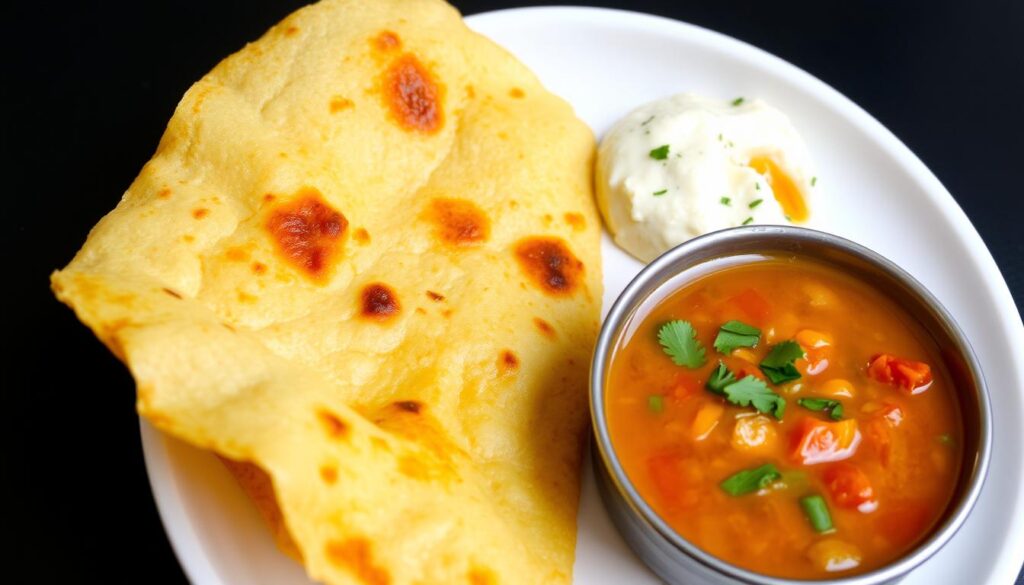
Dosa is another popular South Indian breakfast dish that comes in various forms. The basic dosa recipe involves fermenting a batter of rice and lentils, then spreading it thinly on a hot griddle.
There are many varieties of dosa, including the classic plain dosa, masala dosa (stuffed with spiced potatoes and onions), and rava dosa (made with a semolina batter).
To make a crispy dosa, it’s essential to get the batter right and cook it on a hot griddle with a small amount of oil.
Upma – The Savory Semolina Dish
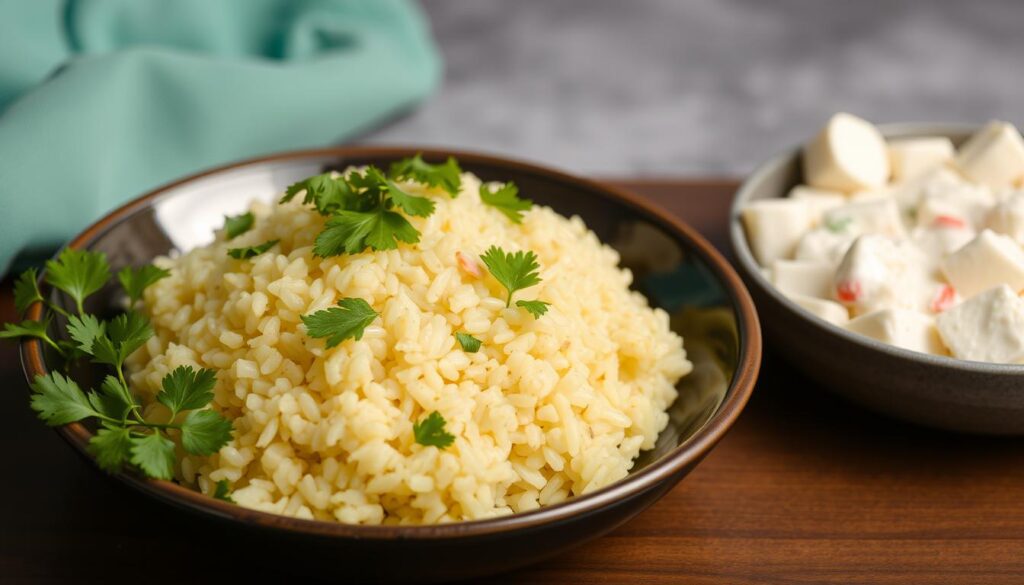
Upma is a simple yet satisfying South Indian breakfast dish made from roasted semolina (rava), vegetables, and spices.
The dish is quick to prepare and can be customized with various vegetables and spices according to taste.
To make upma, roast the semolina in a pan until it’s lightly browned, then sauté onions, ginger, and other desired vegetables in oil before adding water and the roasted semolina.
Pongal – Comfort in a Bowl
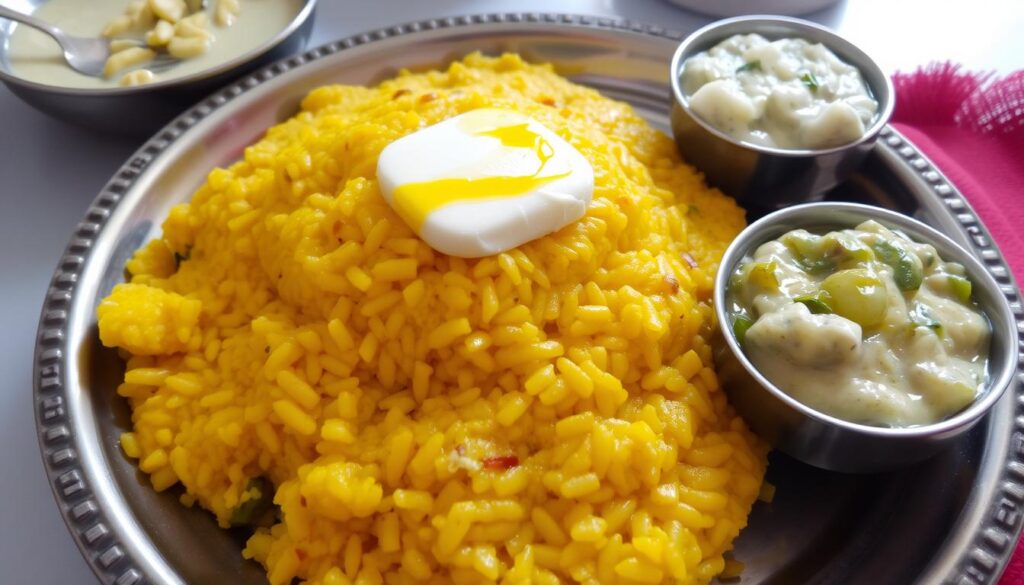
Pongal is a comforting South Indian breakfast dish made with rice and yellow lentils (moong dal). The dish is flavored with spices and often includes ingredients like ginger, black pepper, and cashews.
There are two main types of pongal: sakkarai pongal (sweet pongal) and ven pongal (savory pongal). Ven pongal is a popular breakfast option, especially during the cooler months.
The magic of pongal lies in its tempering, which involves blooming spices like whole black peppercorns, cumin seeds, ginger, and curry leaves in ghee. This creates an aromatic profile that elevates the dish.
North Indian Breakfast Favorites
Exploring North Indian breakfast favorites is a culinary journey worth taking. North India is known for its diverse and rich breakfast traditions, which are deeply rooted in its cultural heritage.
Stuffed Parathas

Stuffed parathas are a staple in North Indian breakfast cuisine. These layered flatbreads are filled with a variety of ingredients, ranging from spiced potatoes to peas and cauliflower. The aloo paratha, filled with mashed potatoes and spices, is particularly popular.
The process of making stuffed parathas involves rolling out the dough, filling it with the desired ingredients, and then cooking it on a griddle with ghee until it’s golden brown and crispy.
Chole Bhature – A Festive Morning Treat
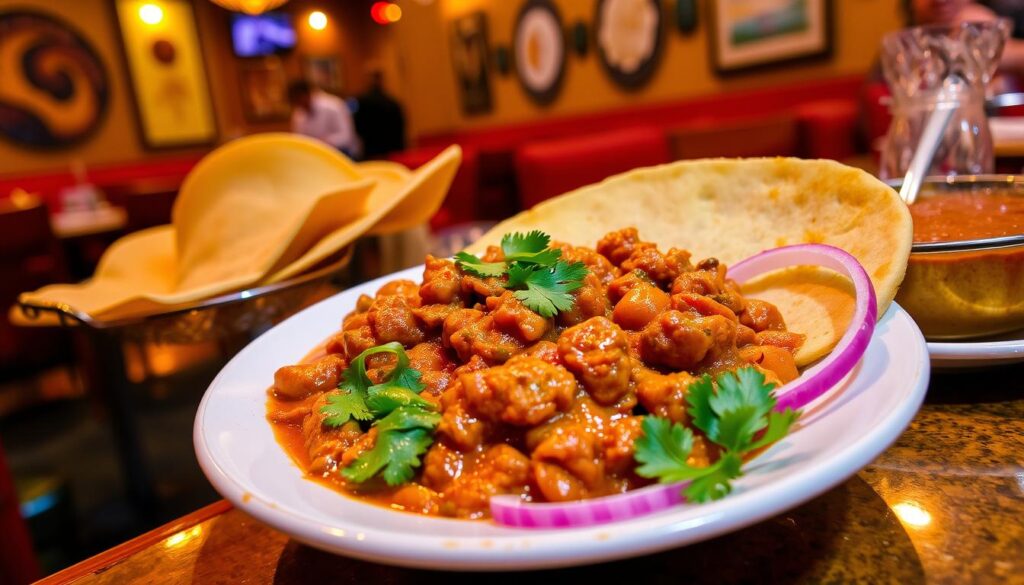
Chole bhature is a festive breakfast dish that consists of spicy chickpea curry (chole) served with a deep-fried bread (bhature). This combination is a favorite in many North Indian households and is often enjoyed during special occasions.
The preparation of chole bhature involves marinating the chickpeas and spices, then cooking them in a rich tomato-based gravy. The bhature is made by deep-frying dough that has been allowed to ferment, giving it a light and airy texture.
Poha – Flattened Rice Delight
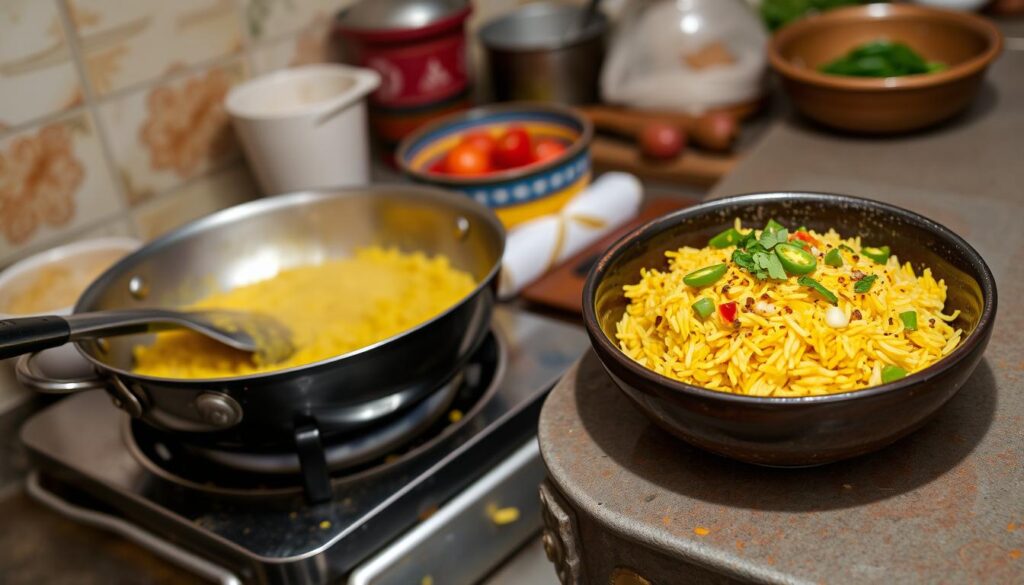
Poha, or flattened rice, is a popular breakfast option in North India. It’s made by soaking flattened rice flakes in water, then mixing them with a variety of spices, nuts, and sometimes even vegetables.
Poha is not only delicious but also nutritious and easy to digest. It’s often served with a sprinkle of fresh coconut and coriander for added flavor.
Masala Omelet – Indian Style Eggs
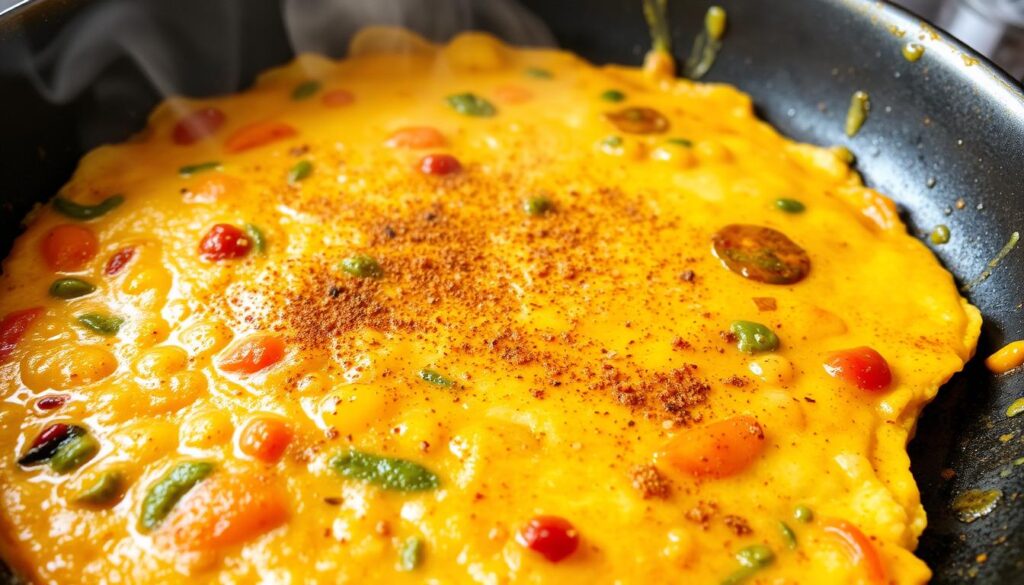
The masala omelet is an elevated version of the traditional omelet, loaded with onions, cilantro, green pepper, tomatoes, and a blend of spices. It’s a protein-rich breakfast option that can be paired with paratha, toast, or even wrapped in a roti.
The secret to a perfect masala omelet lies in the spice blend and cooking it in ghee for a nutty flavor. Regional variations exist, with some adding fresh coconut or curry leaves to give it a unique twist.
Adding vegetables like bell peppers, spinach, or mushrooms enhances the nutritional profile and creates a textural contrast, making the dish more substantial.
Western Indian Breakfast Specialties
From savory steamed cakes to versatile flatbreads, Western Indian breakfasts offer a delightful array of options. You can explore the rich culinary traditions of this region through its diverse breakfast dishes.
Dhokla – Steamed Savory Cake
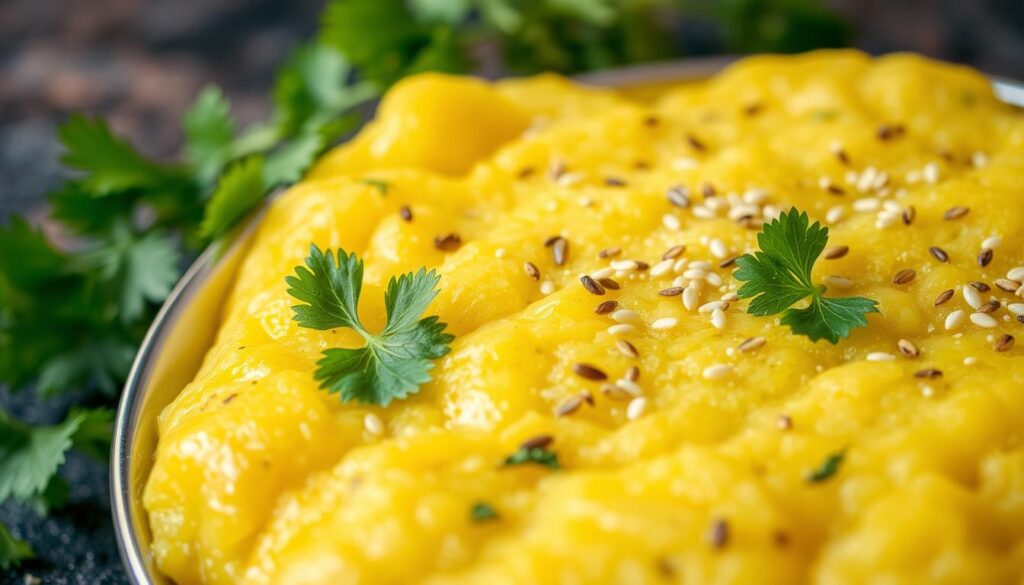
Dhokla is a popular Gujarati breakfast dish made from a fermented batter of gram flour and yogurt. The fermentation process gives dhokla its characteristic softness and a slightly tangy flavor. You can make an instant dhokla recipe by using a pre-mixed dhokla flour or by simplifying the fermentation process.
The steaming process involved in making dhokla helps retain its nutritional value, making it a healthy breakfast option. You can flavor dhokla with various ingredients like ginger, green chilies, and curry leaves to enhance its taste.
Thepla – Versatile Flatbread
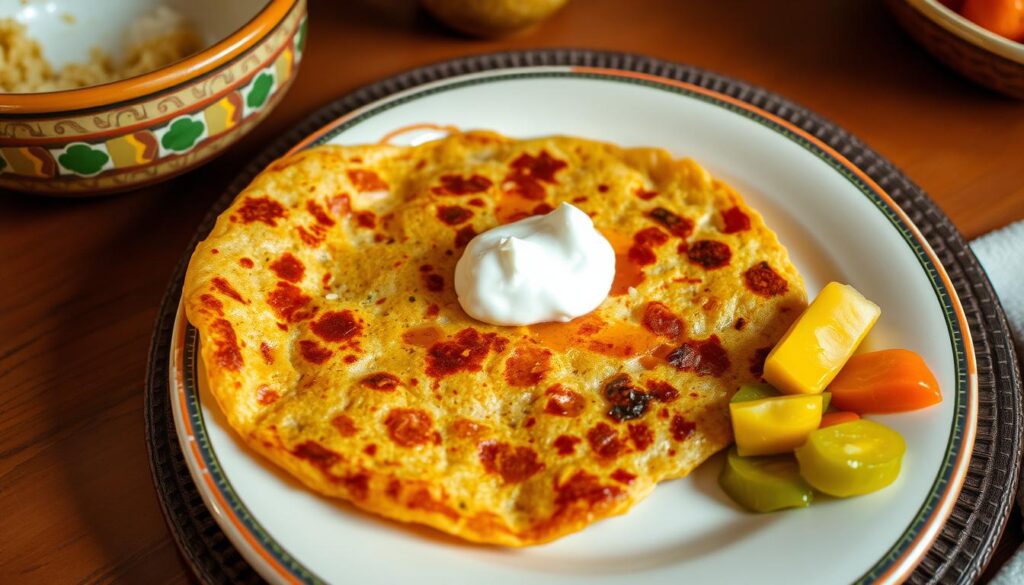
Thepla is a versatile flatbread originating from Gujarat, typically made with whole wheat flour, yogurt, and a mix of spices. You can customize thepla by adding different herbs like methi (fenugreek leaves) to give it a unique flavor. A methi thepla recipe is a great way to incorporate greens into your breakfast.
Thepla is not only delicious but also convenient, as it can be stored for a few days and served as needed. You can enjoy it with a variety of accompaniments like yogurt, pickle, or chutney.
Kanda Poha – Maharashtra’s Favorite
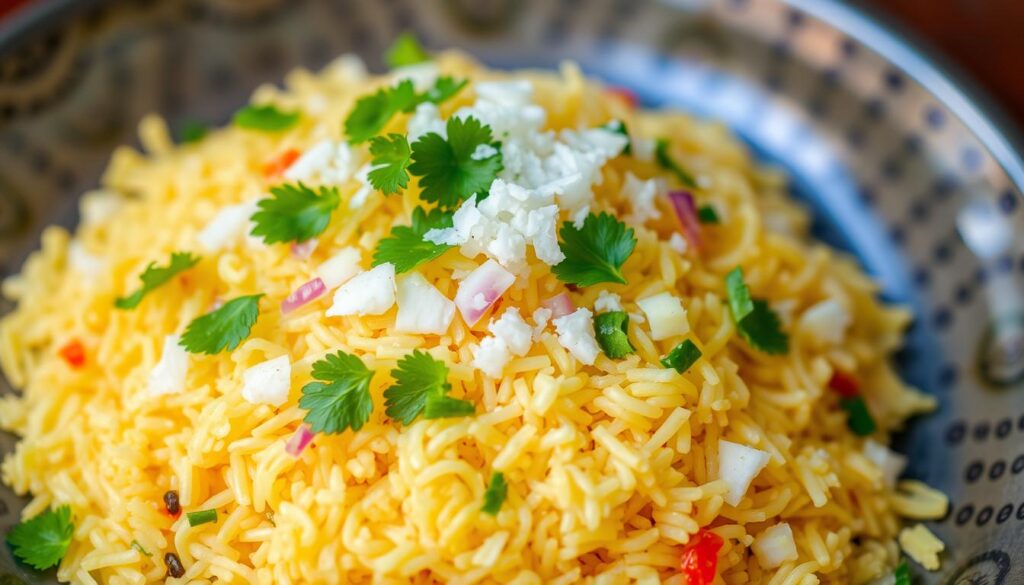
Kanda Poha is a beloved Maharashtrian breakfast dish made with flattened rice flakes (poha), onions (kanda), and a tempering of mustard seeds, chillies, and curry leaves. You think of poha, you think of Maharashtra, and the addition of onions gives it a distinctive flavor and texture.
The preparation of kanda poha involves a delicate balance of rinsing the poha to the right consistency and cooking the onions to bring out their sweetness. You can personalize kanda poha with regional touches, such as adding grated coconut for sweetness or diced potatoes for heartiness. Serving it with a side of yogurt adds a creamy element to the dish.
The popularity of kanda poha extends beyond breakfast, as it’s often enjoyed as an afternoon snack or light dinner, showcasing its versatility and the affection Maharashtrians have for this humble yet satisfying preparation.
Eastern Indian Breakfast Treasures
Exploring Eastern Indian breakfast options reveals a diverse and vibrant culinary landscape. The region’s morning meals are a testament to its rich cultural heritage and the variety of ingredients available locally.
Luchi with Aloo Dum
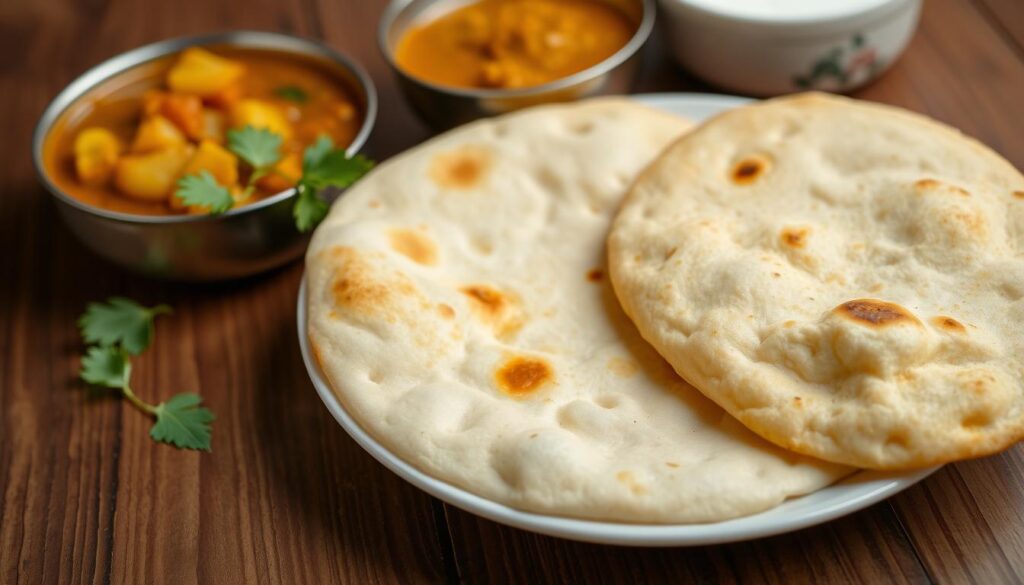
Luchi with Aloo Dum is a quintessential Bengali breakfast dish that combines the simplicity of puffed bread with the richness of a potato curry. Luchi, made from refined flour, is deep-fried to achieve a puffed texture, while Aloo Dum is a slow-cooked potato curry flavored with a blend of spices.
This comforting breakfast is not only delicious but also reflects the culinary traditions of Eastern India. The combination of luchi and aloo dum provides a satisfying start to the day, with the carbohydrates from the bread and the protein and fiber from the potatoes.
Dal Parathas – Protein-Packed Start
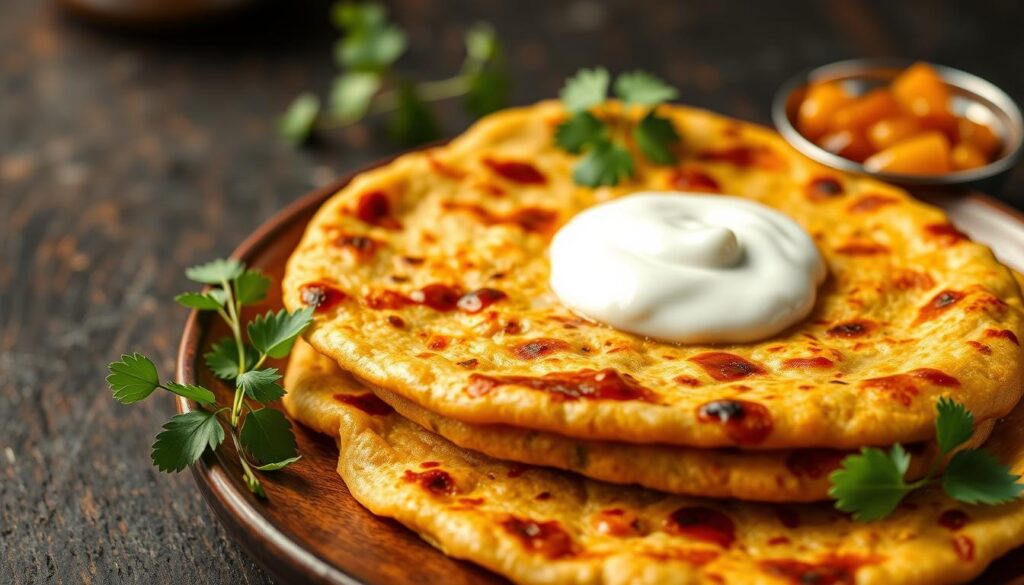
Dal Parathas represent Eastern India’s ingenious solution for incorporating protein-rich lentils into breakfast, creating a complete meal in a single flatbread that provides sustained energy. The filling typically features chana dal (split Bengal gram) or moong dal (split green gram) that’s cooked until soft, seasoned with cumin, ginger, and green chilies, then mashed to create a smooth stuffing.
The whole wheat dough encasing the lentil filling adds complex carbohydrates and fiber, making these parathas significantly more nutritious than their plain counterparts. The technique for stuffing these parathas requires practice—the lentil mixture must be cool and dry enough not to tear the dough, while the rolling requires a gentle touch to maintain an even thickness.
Regional variations exist throughout Eastern India, with some recipes incorporating rice lentil mixtures, while others add fresh fenugreek or spinach to the dough for additional nutrition and flavor. These parathas are traditionally served with a dollop of fresh yogurt and pickle, though they’re substantial enough to be enjoyed on their own, making them perfect for busy mornings or packed breakfasts.
Quick and Easy Indian Breakfast Options
You can kick-start your morning with a range of quick and easy Indian breakfast dishes that not only tantalize your taste buds but also provide the energy needed for the day ahead.
Rava Uttapam – Instant Savory Pancakes
Rava Uttapam is a popular South Indian breakfast dish that is essentially a savory pancake made from semolina, yogurt, and a variety of vegetables. To make Rava Uttapam, start by preparing a batter with semolina, yogurt, grated vegetables like carrots and zucchini, and spices. The batter is then poured onto a hot griddle greased with ghee and cooked until it’s golden brown on both sides.
The beauty of Rava Uttapam lies in its versatility; you can easily personalize it by adding your favorite vegetables. It’s typically served with coconut chutney, making it a delicious and satisfying breakfast option.
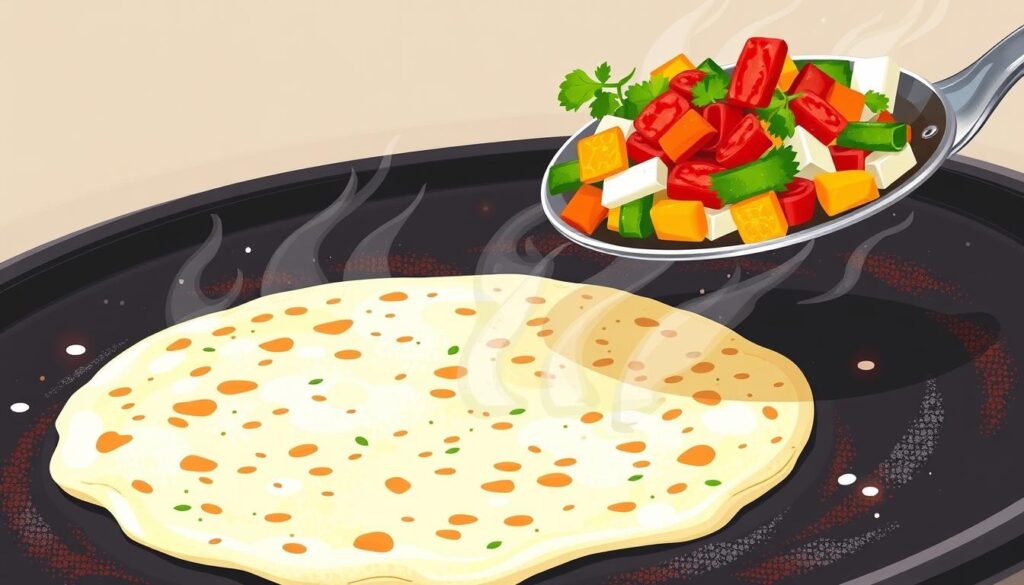
Bread Upma – Fusion Breakfast
Bread Upma represents a creative twist on traditional breakfast dishes by transforming leftover bread into a flavorful meal. To prepare Bread Upma, start by lightly toasting bread cubes to prevent sogginess. Then, create a tempering with mustard seeds, curry leaves, onions, and tomatoes, and combine it with the toasted bread cubes.
One of the advantages of Bread Upma is its quick preparation time; it can be made in just 15 minutes, making it perfect for busy mornings. You can also customize it by adding boiled potatoes, green peas, or grated carrots, thus incorporating vegetables into your breakfast without extra preparation.
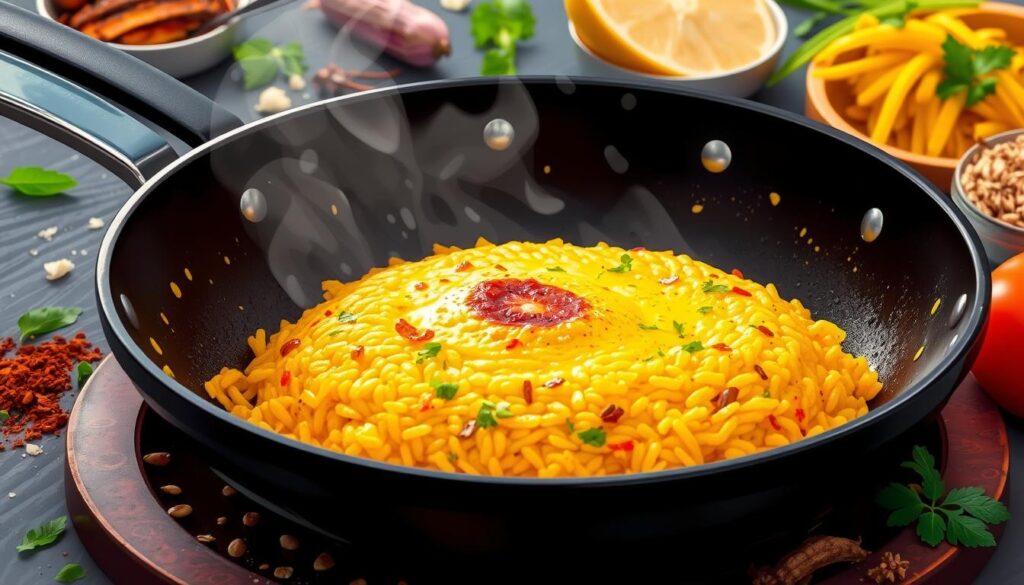
Accompaniments for Indian Breakfast
When it comes to Indian breakfast, the accompaniments play a crucial role in elevating the meal. These additions not only enhance the flavor but also add texture and depth to the dishes.
One of the key accompaniments to Indian breakfast is chutneys and pickles. Chutneys, made from a variety of ingredients such as coconut, tomato, or mint, add a burst of flavor to the meal. Pickles, on the other hand, provide a tangy and spicy contrast to the dishes. You can enjoy them with various breakfast items like idlis, dosas, or parathas.
Chutneys and Pickles
Chutneys and pickles are an integral part of Indian breakfast. They are made using a variety of ingredients and spices, and their preparation methods vary across regions. For instance, coconut chutney is a staple in South Indian cuisine, often served with idlis and dosas. In contrast, North Indian cuisine favors pickles made with mango or lime.
A simple table comparing different types of chutneys and pickles is given below:
| Type | Region | Common Ingredients |
|---|---|---|
| Coconut Chutney | South India | Coconut, Green Chilies, Cilantro |
| Mango Pickle | North India | Mango, Mustard Oil, Spices |
| Tomato Chutney | East India | Tomato, Onions, Garlic |
Beverages – Chai and Coffee
No Indian breakfast is complete without a hot beverage. Masala chai is the most popular choice, made with black tea, milk, and a blend of spices like cardamom, cinnamon, and ginger. In recent years, coffee has also gained popularity, especially among the younger generation.
South Indian filter coffee is a robust alternative, prepared using a traditional metal filter and mixed with hot milk using a distinctive “pulling” technique. The addition of chicory enhances its flavor profile. You can also experiment with modern adaptations like turmeric lattes or spiced buttermilk served with ghee-rich breakfasts to aid digestion.
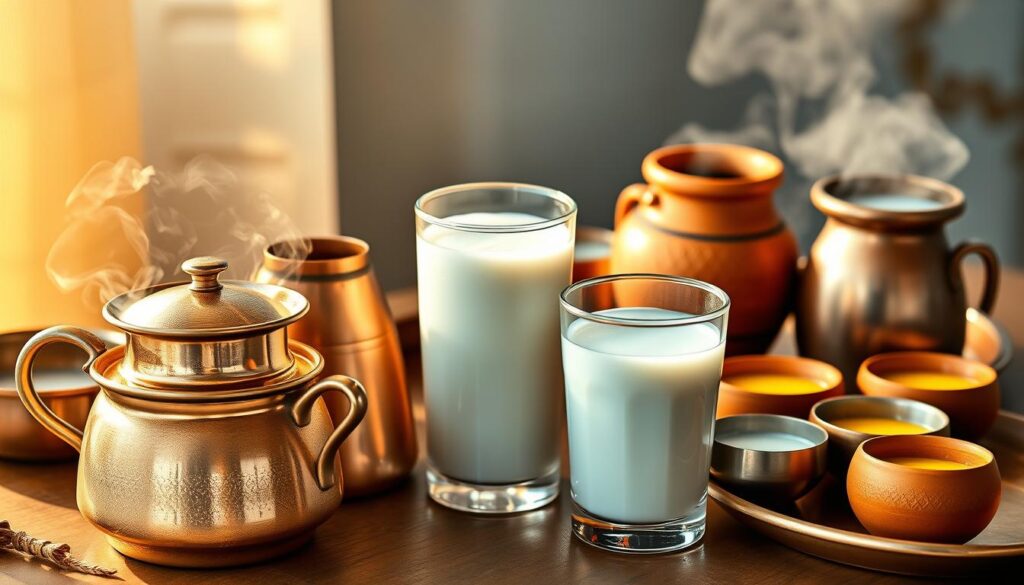
Understanding the proper preparation of these beverages is essential for creating an authentic Indian breakfast experience. Whether you prefer the comforting ritual of masala chai or the rich flavor of filter coffee, these beverages complement the meal perfectly.
Some people also enjoy having a dollop of yogurt with their breakfast, adding a tangy and cooling contrast to the spicy and savory dishes.
Tips for Making Perfect Indian Breakfast at Home
Preparing Indian breakfast at home can be effortless with a few expert tips. To start your day on a delicious note, understanding the right techniques and planning ahead is crucial. Indian breakfast recipes offer a diverse range of options, from South Indian delights like idli and dosa to North Indian favorites such as parathas and chole bhature.
Preparation Techniques
Mastering certain preparation techniques can simplify the process of making Indian breakfast. For instance, fermenting idli and dosa batter requires patience, but doing it over the weekend allows you to enjoy fresh South Indian breakfast on busy weekday mornings with minimal effort. Similarly, pre-mixing dry ingredients for quick breakfasts like upma or poha and storing them in airtight containers can save significant preparation time.
- Prepare idli and dosa batter in advance and refrigerate it for up to a week.
- Pre-mix dry ingredients for recipes like upma or poha and store them in labeled containers.
- Create “breakfast kits” with measured spices and pre-chopped ingredients for easy preparation.
Make-Ahead Options
Make-ahead options are a lifesaver for busy mornings. Paratha dough can be prepared in advance and stored in the refrigerator for 2-3 days. Cooked parathas can be frozen and reheated directly from frozen in a hot skillet, making it a convenient breakfast recipe. Chutneys generally stay fresh in the refrigerator for 3-4 days, so preparing a batch on Sunday can serve you throughout the week.
- Prepare paratha dough in advance and store it in the refrigerator.
- Portion and freeze curry bases like chole gravy for future use.
- Make a batch of chutney on Sunday to use throughout the week.
By incorporating these tips into your daily routine, you can enjoy a variety of delicious Indian breakfast recipes every day. Whether you’re making a simple version of poha or a more elaborate recipe like chole bhature, the key is to plan ahead and use the right preparation techniques.
Conclusion
As we conclude our culinary journey through traditional Indian breakfast dishes, it’s clear that the diversity and richness of Indian cuisine offer something for everyone. The regional diversity of Indian breakfast cuisine ensures that there’s a dish to suit every palate, from the fermented rice specialties of South India to the hearty wheat-based dishes of the North.
By exploring these traditional breakfast recipes, you’re not just enjoying delicious food, but also embracing centuries-old culinary traditions that have nourished generations of people. Many Indian breakfast dishes are adaptable to dietary restrictions, offering numerous naturally vegetarian, vegan, or gluten-free options that don’t compromise on flavor or satisfaction.
The nutritional wisdom embedded in traditional breakfast combinations offers valuable lessons for modern approaches to morning nutrition. Whether you’re drawn to the quick convenience of poha or the comforting warmth of parathas, Indian breakfast cuisine provides options for every morning scenario. You can even create your own version of these dishes, incorporating ingredients that suit your taste and nutritional needs. Many of these dishes double as perfect snack or light meals throughout the day.

